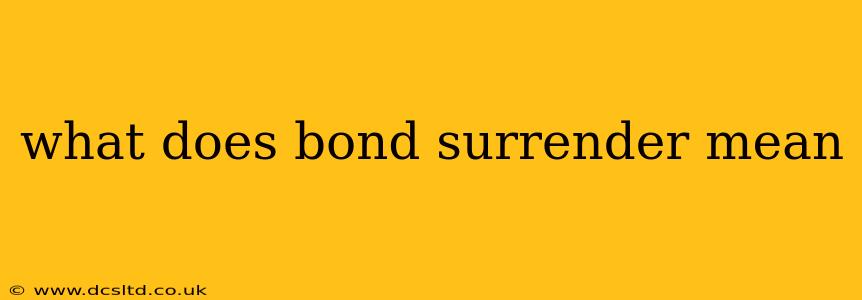Bond surrender refers to the process of selling a bond back to the issuer before its maturity date. This is distinct from letting the bond mature and receiving its face value at the end of its term. Understanding bond surrenders involves grasping several key aspects, including the implications for your investment and the potential gains or losses involved.
Why Would Someone Surrender a Bond?
Several reasons might prompt an investor to surrender a bond prematurely:
-
Need for Cash: Sometimes, unforeseen circumstances require immediate access to funds, forcing a bondholder to sell their bond before maturity. This might be for emergency expenses, a sudden investment opportunity, or other pressing financial needs.
-
Changing Interest Rates: If interest rates rise after you've purchased a bond, newly issued bonds will likely offer higher yields. Surrendering your existing bond and reinvesting in a higher-yielding one can improve your overall return. Conversely, if interest rates fall significantly, you might choose to hold onto your bond, especially if it offers a higher coupon rate than what's currently available.
-
Investment Strategy Adjustment: A change in investment strategy might necessitate surrendering bonds to reallocate capital into other assets considered more promising or better aligned with the investor's risk tolerance.
-
Bond Default Concerns: If an investor becomes concerned about the issuer's ability to repay the bond at maturity (i.e., the risk of default increases), they might choose to surrender the bond to minimize potential losses. This is a particularly risky situation, as you will likely sell the bond at a loss if the market anticipates a default.
What Happens During a Bond Surrender?
The process of surrendering a bond generally involves contacting your broker or the issuer (if you hold the bond directly). The issuer will then purchase the bond from you. However, the price you receive won't necessarily be the face value of the bond.
This is where the concept of "market price" becomes crucial. The price you receive for surrendering a bond will be determined by its current market value, which fluctuates based on various factors such as interest rates, credit rating of the issuer, and overall market conditions. Often, you'll receive less than the face value, especially if interest rates have risen since you purchased the bond.
What are the Potential Costs of Surrendering a Bond?
Surrendering a bond before maturity often comes with costs, primarily:
- Loss of potential interest: You will forgo any future interest payments you would have received had you held the bond until maturity.
- Selling at a discount: As mentioned above, you'll likely receive less than the face value of the bond, resulting in a capital loss.
- Early withdrawal penalties: Some bonds may have early withdrawal penalties stipulated in their terms and conditions. This added cost further reduces your net proceeds from the surrender.
How Does Bond Surrender Differ from Redemption?
While both involve returning a bond to the issuer, there's a key difference:
- Surrender: This is initiated by the bondholder before maturity.
- Redemption: This is initiated by the issuer at maturity or at a specified call date. Redemption typically involves receiving the face value of the bond.
Can I surrender a bond anytime?
Not all bonds are equally easy to surrender. Some bonds are callable, meaning the issuer has the right to redeem them before maturity. Others are non-callable, offering greater protection to the bondholder against early redemption. Always check your bond's terms and conditions to understand its surrender provisions and any associated penalties.
In summary, bond surrender is a strategic decision with financial implications. Weighing the potential benefits against the potential costs is critical before choosing to surrender a bond. Consulting with a financial advisor can provide personalized guidance based on your specific circumstances and investment objectives.
